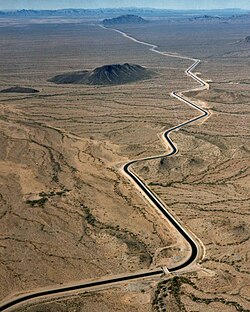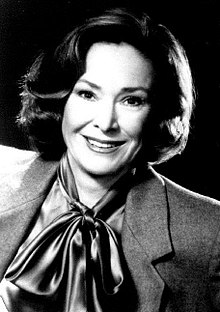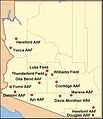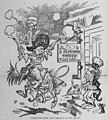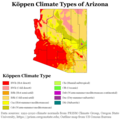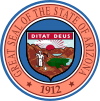Portal:Arizona
| Showcase | Content |
Welcome to the Arizona portal!
Arizona (/ˌærɪˈzoʊnə/ ARR-ih-ZOH-nə; Navajo: Hoozdo Hahoodzo [hoː˥z̥to˩ ha˩hoː˩tso˩]; O'odham: Alĭ ṣonak [ˈaɭi̥ ˈʂɔnak]) is a landlocked state in the Southwestern region of the United States. Arizona is part of the Four Corners region with Utah to the north, Colorado to the northeast, and New Mexico to the east; its other neighboring states are Nevada to the northwest, California to the west and the Mexican states of Sonora and Baja California to the south and southwest. It is the 6th-largest and the 14th-most-populous of the 50 states. Its capital and largest city is Phoenix. Arizona is the 48th state and last of the contiguous states to be admitted to the Union, achieving statehood on February 14, 1912. Historically part of the territory of Alta California and Nuevo México in New Spain, it became part of independent Mexico in 1821. After being defeated in the Mexican–American War, Mexico ceded much of this territory to the United States in 1848, where the area became part of the territory of New Mexico. The southernmost portion of the state was acquired in 1853 through the Gadsden Purchase. Southern Arizona is known for its desert climate, with very hot summers and mild winters. Northern Arizona features forests of pine, Douglas fir, and spruce trees; the Colorado Plateau; mountain ranges (such as the San Francisco Mountains); as well as large, deep canyons, with much more moderate summer temperatures and significant winter snowfalls. There are ski resorts in the areas of Flagstaff, Sunrise, and Tucson. In addition to the internationally known Grand Canyon National Park, which is one of the world's seven natural wonders, there are several national forests, national parks, and national monuments. Arizona is home to a diverse population. About one-quarter of the state is made up of Indian reservations that serve as the home of 27 federally recognized Native American tribes, including the Navajo Nation, the largest in the state and the country, with more than 300,000 citizens. Since the 1980s, the proportion of Hispanics has grown significantly owing to migration from Mexico. A substantial portion of the population are followers of the Roman Catholic Church and the Church of Jesus Christ of Latter-day Saints. Arizona's population and economy have grown dramatically since the 1950s because of inward migration, and the state is now a major hub of the Sun Belt. Cities such as Phoenix and Tucson have developed large, sprawling suburban areas. Many large companies, such as PetSmart and Circle K, have headquarters in the state, and Arizona is home to major universities, including the University of Arizona and Arizona State University. The state is known for a history of conservative politicians such as Barry Goldwater and John McCain, though it has become a swing state since the 1990s. (Full article...) Selected article -The governor of Arizona is the head of government of the U.S. state of Arizona. As the top elected official, the governor is the head of the executive branch of the Arizona state government and is charged with faithfully executing state laws. The governor has the power to either approve or veto bills passed by the Arizona State Legislature; to convene the legislature; and to grant pardons, except in cases of impeachment. The governor is also the commander-in-chief of the state's military forces. Twenty-four people have served as governor over 28 distinct terms. All of the repeat governors were in the state's earliest years, when George W. P. Hunt and Thomas Edward Campbell alternated as governor for 17 years and, after a two-year gap, Hunt served another term. One governor, Evan Mecham, was successfully impeached, and one, Fife Symington, resigned upon being convicted of a felony. The longest-serving governor was Hunt, who was elected seven times and served just under fourteen years. The longest single stint was that of Bruce Babbitt, who was elected to two four-year terms after succeeding to the office following the death of his predecessor, Wesley Bolin, serving nearly nine years total. Bolin had the shortest tenure, dying less than five months after succeeding as governor. Arizona has had five female governors, the most in the United States, and was the first—and until 2019 (when Michelle Lujan Grisham succeeded Susana Martinez in neighboring New Mexico) the only—state where female governors served consecutively. (Full article...)Did you know (auto-generated) -
Selected picture -
The Central Arizona Project Aqueduct is a diversion canal in Arizona in the United States. The aqueduct diverts water from the Colorado River from Lake Havasu City into central and southern Arizona. The Central Arizona Project is a multipurpose water resource development and management project that was designed to provide water to nearly one million acres (4,000 km²) of Indian and non-Indian irrigated agricultural land areas as well as municipal water for several Arizona communities. More did you know -
WikiProjects
Selected biography -Joan Ganz Cooney (born Joan Ganz; November 30, 1929) is an American television writer and producer. She is one of the founders of Sesame Workshop (formerly Children's Television Workshop or CTW), the organization famous for the creation of the children's television show Sesame Street, which was also co-created by her. Cooney grew up in Phoenix and earned a Bachelor of Arts in education from the University of Arizona in 1951. After working for the State Department in Washington, D.C., and as a journalist in Phoenix, she worked as a publicist for television and production companies in New York City. In 1961, she became interested in working for educational television, and became a documentary producer for New York's first educational TV station WNET (Channel 13). Many of the programs she produced won local Emmys. In 1966, Cooney hosted what she called "a little dinner party" at her apartment near Gramercy Park. In attendance was her then-husband Tim Cooney, her boss Lewis Freedman, and Lloyd Morrisett, an executive at the Carnegie Corporation, in which the potential of television to teach young children was discussed. Cooney was chosen to oversee and direct the creation of what eventually became the children's television program Sesame Street, which premiered in 1969, and the CTW, the organization that oversaw its production. Cooney was named CTW's first executive director. As one of the first female executives in American television, her appointment was called "one of the most important television developments of the decade". (Full article...)General images -The following are images from various Arizona-related articles on Wikipedia.
News
Wikinews Arizona portal
CategoriesRelated portalsTopicsState facts
State symbols:
Recognized content
Featured articles
Featured lists
Good articles
Featured pictures
Things you can doAssociated WikimediaThe following Wikimedia Foundation sister projects provide more on this subject:
Discover Wikipedia using portals | |||||||||||||||||






